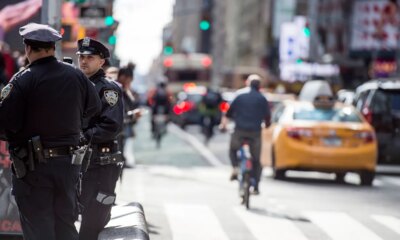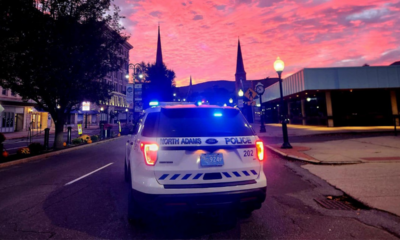News
Southern California rain helps firefighters but creates risk of toxic ash runoff
LOS ANGELES (AP) — After weeks of windy and dry weather, rain has fallen in parched Southern California and is expected to aid firefighters who are mopping up multiple wildfires. But potentially heavy downpours on charred hillsides could bring new troubles such as toxic ash runoff.
Los Angeles County crews spent much of the past week removing vegetation, shoring up slopes and reinforcing roads in devastated areas of the Palisades and Eaton fires, which reduced entire neighborhoods to rubble and ash after breaking out during powerful winds Jan. 7.
Most of the region was forecast to get around an inch (about 2.5 centimeters) of precipitation over several days, but “the threat is high enough to prepare for the worst-case scenario” of localized cloudbursts causing mud and debris to flow down hills, the National Weather Service said on social media.
“So the problem would be if one of those showers happens to park itself over a burn area,” weather service meteorologist Carol Smith said. “That could be enough to create debris flows.”
Rainfall that began late Saturday was expected to increase Sunday and possibly last into early Tuesday, forecasters said. Flood watches were issued for some burn areas, while snow was likely in the mountains.
Los Angeles Mayor Karen Bass issued an executive order last week to expedite cleanup efforts and mitigate the environmental impacts of fire-related pollutants. LA County supervisors also approved an emergency motion to install flood-control infrastructure and expedite and remove sediment in fire-impacted areas.
Fire crews filled sandbags for communities, while county workers installed barriers and cleared drainage pipes and basins.
Officials cautioned that ash in recent burn zones was a toxic mix of incinerated cars, electronics, batteries, building materials, paints, furniture and other household items. It contains pesticides, asbestos, plastics and lead. Residents were urged to wear protective gear while cleaning up.
Concerns about post-fire debris flows have been especially high since 2018, when the town of Montecito, up the coast from LA, was ravaged by mudslides after a downpour hit mountain slopes burned bare by a huge blaze. Hundreds of homes were damaged and 23 people died.
While the impending wet weather ended weeks of dangerous gusts and reduced humidity, several wildfires were still burning Saturday across Southern California. Those included the Palisades and Eaton fires, which killed at least 28 people and destroyed more than 14,000 structures. Containment of the Palisades Fire reached 81% on Saturday and the Eaton Fire was 95% contained.
In northern Los Angeles County, firefighters made significant progress against the Hughes Fire, which prompted evacuations for tens of thousands of people when it erupted on Wednesday in mountains near Lake Castaic.
In San Diego County, there was still little containment of the Border 2 Fire as it burned through a remote area of the Otay Mountain Wilderness near the U.S.-Mexico border.
The rain was expected to snap a near-record streak of dry weather for Southern California. Much of the region has received less than 5% of the average rainfall for this point in the water year, which began Oct. 1, the Los Angeles Times reported Saturday.
Most of Southern California is currently in “extreme drought” or “severe drought,” according to the U.S. Drought Monitor.

News
Manhunt under way for attacker after two students killed at US university

More than 400 law enforcement personnel have been deployed as police search for the suspect in a shooting at Brown University in Rhode Island in which two students were killed and nine wounded, US officials said.
The Ivy League university in Providence remained in lockdown early on Sunday, several hours after a suspect with a firearm entered a building where students were taking exams on Saturday. Streets around the campus were packed with emergency vehicles hours after the shooting, and security was heightened around the city as law enforcement agencies continued their manhunt.
list of 3 itemsend of listRecommended Stories
The suspect remained at large, officials said, as police worked with agents from the FBI and the Bureau of Alcohol, Tobacco, Firearms and Explosives to search streets and buildings around the campus to find the individual.
Saturday’s shooting is the second major incident of gun violence on a university campus this week.
Providence deputy police chief Timothy O’Hara said the suspect had not been identified.
Officials said they would release a video of the suspect, a male possibly in his 30s and dressed in black, who O’Hara said may have been wearing a mask. He said officials had retrieved shell casings from the scene of the shooting, but that police were not prepared to release more details of the attack.
Providence Mayor Brett Smiley has confirmed that two students were killed and nine people were injured in the attack.
At a news conference, Smiley said university leaders became aware of the shooting at about 4:05pm local time (21:05 GMT), when emergency responders received a 911 call.
Smiley declined to identify the shooting victims, citing the ongoing investigation. However, he sought to reassure the community, despite a shelter-in-place order for the Brown campus and the surrounding neighbourhood.
“We have no reason to believe there are any additional threats at this time,” he said.
The university’s president, Christina Paxton, explained she had been on a flight to Washington, DC, when she learned of the shooting. She immediately returned to Providence to attend a night-time news conference.
“This is a day that we hoped never would come to our community. It is deeply devastating for all of us,” Paxton said in a written statement.
At the news conference, Paxton said she was told the victims were students.
Suspect remains at large
At approximately 4:22pm local time (21:22 GMT), the university issued its first emergency update, warning that there was an armed man near the Barus and Holley engineering and physics building.
“Lock doors, silence phones and stay hidden until further notice,” the university said in its update.
“Remember: RUN, if you are in the affected location, evacuate safely if you can; HIDE, if evacuation is not possible, take cover; FIGHT, as a last resort, take action to protect yourself.”
Upon arriving at the scene, law enforcement swept the building, according to Providence police’s O’Hara.
“They did a systematic search of the building. However, no suspect was located at that time,” O’Hara said.
The university had to withdraw an early announcement that a suspect had been apprehended, writing, “Police do not have a suspect in custody and continue to search for suspect(s).”
US President Donald Trump published a similar retraction on his online platform, Truth Social, after erroneously posting at about 5:44pm (22:44 GMT) that a suspect had been detained.
Mayor Smiley said there were 400 law enforcement officers in the area to search for the suspect.
He also encouraged witnesses to come forward with any information about the shooting.
The seventh-oldest university in the US, Brown is considered part of the prestigious Ivy League, a cluster of private research colleges in the northeast. Its student body numbers 11,005, according to its website.
On December 9, Kentucky State University in the southern city of Frankfort also experienced gunfire on campus, killing one student and leaving a second critically injured.
The suspect in that case was identified as Jacob Lee Bard, the parent of a student at the school.
News
Video: At Least Two Killed in Shooting at Brown University

new video loaded: At Least Two Killed in Shooting at Brown University
transcript
transcript
At Least Two Killed in Shooting at Brown University
Students remained locked in their dorms and classrooms as the police searched for the shooter, who was described as a man wearing black. At least two people are dead, and eight are in critical condition.
-
At 4:00 in the afternoon, we received a call. 4:05 was when the initial call came in to Brown University of a report of an active shooter. I can confirm that there are two individuals who have died this afternoon, and there are another eight in critical status. We do not have a shooter in custody at this time. There is a shelter in place in effect for the greater Brown University area. If you live on or near Brown’s campus, we are encouraging you to stay home and stay inside. This is a sad state of our country right now where you have to plan for these things. And hopefully the community takes some comfort to know that their Providence leadership has planned for this occurrence, including very recently.
By McKinnon de Kuyper
December 13, 2025
News
Multiple people shot near Brown University, police say

In this image from video, law enforcement officials gather outside the Brown University campus in Providence, R.I., on Saturday, Dec. 13, 2025.
Kimberlee Kruesi/AP
hide caption
toggle caption
Kimberlee Kruesi/AP
Multiple people have been shot near Brown University in Providence, R.I., on Saturday, police said.
The Providence Police Department said it is actively investigating the situation and is encouraging the public to shelter in place until further notice.
There is no suspect in custody, the university said on X, adding that it’s coordinating with multiple law enforcement agencies to search for a suspect.
The university issued an alert Saturday afternoon that the shooter was spotted near the Barus and Holley building, which houses the School of Engineering and Physics Department.
“Continue to shelter in place. Remain away from Barus & Holley area. Police do not have a suspect in custody and continue to search for suspect(s). Brown coordinating with multiple law enforcement agencies on site,” the university said.
This is a developing story and will be updated.
-

 Alaska1 week ago
Alaska1 week agoHowling Mat-Su winds leave thousands without power
-

 Texas1 week ago
Texas1 week agoTexas Tech football vs BYU live updates, start time, TV channel for Big 12 title
-
Ohio1 week ago
Who do the Ohio State Buckeyes hire as the next offensive coordinator?
-

 Washington5 days ago
Washington5 days agoLIVE UPDATES: Mudslide, road closures across Western Washington
-

 Iowa7 days ago
Iowa7 days agoMatt Campbell reportedly bringing longtime Iowa State staffer to Penn State as 1st hire
-

 Miami, FL1 week ago
Miami, FL1 week agoUrban Meyer, Brady Quinn get in heated exchange during Alabama, Notre Dame, Miami CFP discussion
-

 Cleveland, OH7 days ago
Cleveland, OH7 days agoMan shot, killed at downtown Cleveland nightclub: EMS
-
World6 days ago
Chiefs’ offensive line woes deepen as Wanya Morris exits with knee injury against Texans





















